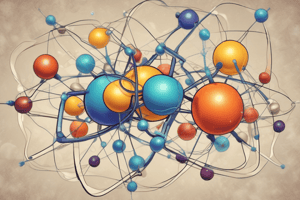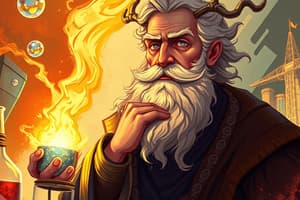Podcast
Questions and Answers
What is an atom?
What is an atom?
Smallest particle of an element that retains its identity in a chemical reaction.
What did Democritus believe about atoms?
What did Democritus believe about atoms?
- Atoms are made of smaller particles.
- Atoms are visible.
- Atoms are invisible and indestructible. (correct)
- Atoms are destructible.
What are subatomic particles?
What are subatomic particles?
Protons, neutrons, and electrons.
Electrons are positively charged subatomic particles.
Electrons are positively charged subatomic particles.
What is the purpose of scanning tunneling microscopes?
What is the purpose of scanning tunneling microscopes?
What did J.J. Thomson discover?
What did J.J. Thomson discover?
What are protons?
What are protons?
What is the nucleus of an atom?
What is the nucleus of an atom?
What is an isotope?
What is an isotope?
What does atomic number represent?
What does atomic number represent?
What is the formula to calculate the number of neutrons?
What is the formula to calculate the number of neutrons?
What is the mass number?
What is the mass number?
What is the atomic mass unit (AMU)?
What is the atomic mass unit (AMU)?
What is a cation?
What is a cation?
What is a group in the periodic table?
What is a group in the periodic table?
What does the periodic table display?
What does the periodic table display?
Anions are positively charged ions.
Anions are positively charged ions.
Flashcards
What is an atom?
What is an atom?
The smallest unit of matter that retains an element's chemical identity.
What is Dalton's Atomic Theory?
What is Dalton's Atomic Theory?
Atoms are indivisible, atoms of the same element are identical, and elements combine in whole-number ratios.
What are Scanning Tunnel Microscopes?
What are Scanning Tunnel Microscopes?
Microscopes that allow visualization of individual atoms.
What are electrons?
What are electrons?
Signup and view all the flashcards
What is Thomson's Cathode Ray experiment?
What is Thomson's Cathode Ray experiment?
Signup and view all the flashcards
What are protons?
What are protons?
Signup and view all the flashcards
What are neutrons?
What are neutrons?
Signup and view all the flashcards
What is the nucleus?
What is the nucleus?
Signup and view all the flashcards
What are isotopes?
What are isotopes?
Signup and view all the flashcards
What is the atomic number?
What is the atomic number?
Signup and view all the flashcards
What is the mass number?
What is the mass number?
Signup and view all the flashcards
What is atomic mass?
What is atomic mass?
Signup and view all the flashcards
What are periods?
What are periods?
Signup and view all the flashcards
What are groups?
What are groups?
Signup and view all the flashcards
What is the Periodic Table?
What is the Periodic Table?
Signup and view all the flashcards
What are ions?
What are ions?
Signup and view all the flashcards
What are cations?
What are cations?
Signup and view all the flashcards
Study Notes
Atomic Structure Overview
- An atom is the smallest particle of an element that retains its identity in a chemical reaction and is considered electrically neutral.
- The concept of atoms dates back to Democritus, who proposed that atoms are invisible and indestructible but lacked experimental support.
Dalton's Contributions
- John Dalton transformed Democritus's ideas into a scientific theory, proposing that:
- All elements consist of tiny indivisible particles called atoms.
- Atoms of the same element are identical, while those of different elements vary.
- Atoms can combine in simple whole-number ratios to form compounds.
- Chemical reactions involve the separation, combination, or rearrangement of atoms.
Tools and Discoveries
- Scanning Tunnel Microscopes allow for the observation of individual atoms.
- Subatomic particles include protons, neutrons, and electrons.
- Electrons are negatively charged particles found in atoms.
Thomson and Cathode Rays
- J.J. Thomson discovered electrons through his experiments with cathode rays, leading to the Plum Pudding Model of atomic structure.
Protons and Neutrons
- Protons carry a positive charge, are found in the nucleus, and have a mass approximately equal to that of a neutron.
- Neutrons are neutrally charged, also located in the nucleus, and share a mass with protons.
Rutherford's Experiment
- Rutherford's Gold Foil Experiment unexpectedly found that some alpha particles were deflected, leading to the discovery of a dense, positively charged nucleus within the atom.
Atomic Structure Details
- The nucleus consists of protons and neutrons, influencing atomic mass and stability.
- Electrons orbit around the nucleus, occupying most of the atom's volume.
Isotopes and Atomic Numbers
- Isotopes are variants of the same element with differing neutron counts.
- The atomic number indicates the number of protons in an atom's nucleus, defining the element.
- The mass number is the sum of protons and neutrons.
Calculating Neutrons and Mass
- The number of neutrons can be calculated using the formula: Mass Number - Atomic Number = Number of Neutrons.
Element Characteristics
- Elements differ in their atomic structures primarily due to variations in proton numbers.
- Atomic Mass Unit (AMU) is defined as 1/12 the mass of Carbon-12.
Atomic Mass
- Atomic mass is a weighted average of all isotopes of an element, calculated by summing the products of each isotope's mass and its relative abundance.
Periodic Table Organization
- Periods refer to horizontal rows, while groups (or families) refer to vertical columns in the Periodic Table.
- The Periodic Table organizes elements based on recurring properties.
Ions and Charges
- Ions are atoms that have gained or lost electrons, resulting in a net charge.
- Cations are positively charged ions, while anions are negatively charged ions.
Studying That Suits You
Use AI to generate personalized quizzes and flashcards to suit your learning preferences.




